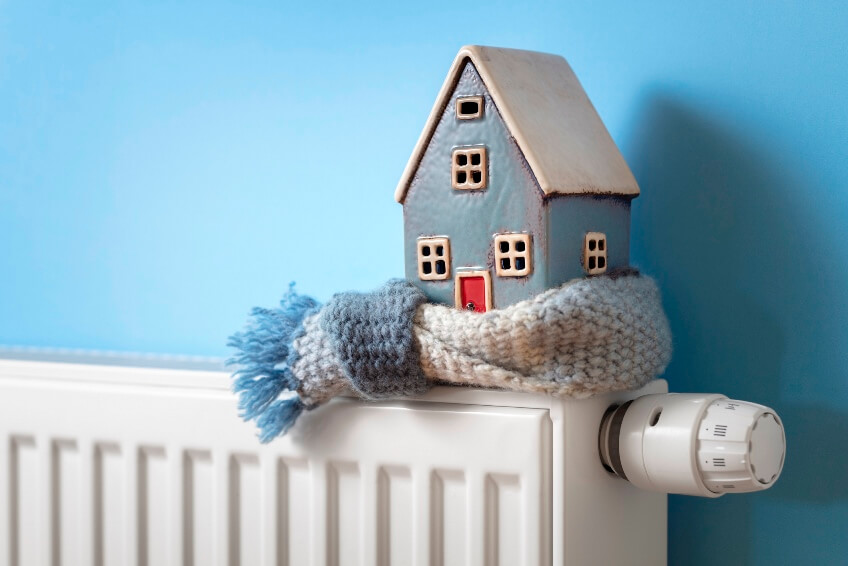On ordinary days, it can easily constitute nearly half of your overall energy bills. But during the peak of winter or summer season, these heating bill expenses tend to surge even more.
Winter, in particular, poses challenges due to the essential nature of heating for survival. While considering heating replacement tends to be costly upfront, it is a viable option to enhance energy efficiency in the long run. But if you’re on a budget, we have straightforward methods to cut down on your heating costs and trim your utility bill without breaking the bank.
1. Upgrade Your Insulation
Is your insulation up to par? Gaps and cracks in windows, doors, walls, and other areas of your home can be major sources of heat loss. Identifying and sealing these gaps is a cost-effective way to improve energy efficiency.
Insulation acts as a barrier that resists the flow of heat. In the context of home heating, it helps to keep the warm air inside during cold weather and prevents heat from entering during hot weather.
Types of Insulation:
There are various types of insulation materials, including
- fiberglass
- cellulose
- foam board
- spray foam
The choice of insulation depends on factors such as climate, budget, and the specific areas of the house that need insulation.
2. Utilize Sunlight to Your Advantage
Make the most of natural and cost-free heat by opening your curtains during the day. Sunlight, a readily available source of warmth, can be effectively captured, especially through south-facing windows.
And when the sun starts setting, draw down the curtains. You might want to consider upgrading your curtains to denser, weightier alternatives. These not only enhance insulation but also contribute a snug and inviting ambiance to your living space.
3. Seal Off Unused Rooms
If there are rooms in your home that you seldom use, close the vents and doors. Focusing heat on the areas you use most frequently can save energy.
Draft stoppers at the bottom of doors can also prevent cold air from creeping into rooms. It should ensure your heating efforts are concentrated where needed.
4. Cook and Bake Strategically
You might not realize this, but your cooking time can also help you improve home heating without skyrocketing your bills. Your oven is a great source of heat. If you want to plan your cooking times strategically, you can purposely coincide them with the cooler parts of the day.
Simmering soups and stews not only warm your kitchen but also provide you with delicious meals. It’s a win-win for comfort and savings.
5. Layer Up with Warm Clothing
It might sound obvious, but sometimes the simplest solutions are the most effective. Wear warmer clothing indoors, allowing you to keep the thermostat a notch lower.
Add a touch of warmth to your living spaces with cozy blankets, throws, and even scented candles. They’re a practical and stylish way to stay warm.
6. Follow Community Tips and Hacks
Connect with your local community to discover unique tips and hacks for saving on heating costs. Your neighborhood might have unique experiences and insights into managing heating costs in specific climates or housing types. Sharing tips within the community creates a collaborative environment where everyone benefits from the shared knowledge.
In some cases, community members may also share government programs from the Department of Energy or incentives that promote energy-efficient practices. It could include subsidies, tax credits, or local initiatives that support residents in making energy-conscious choices.
7. Conduct Regular HVAC Maintenance
Regular maintenance is key to keeping your HVAC system operating at peak efficiency. Over time, wear and tear can affect various components, reducing the system’s overall performance, increasing energy consumption, and requiring you to perform heating repairs.
That makes scheduled maintenance conducted by a professional technician important. Repairmen can inspect, clean, and tune up the system to find issues early and ensure your system’s efficiency doesn’t deteriorate.
Aside from professional maintenance, there are simple tasks that you can perform regularly to extend your heating system’s lifespan.
- Change HVAC filters regularly
- Keep vents and registers clean
- Check for leaks and insulate ducts
- Monitor thermostat settings
8. Consider Solar Heating Options
Solar heating systems harness the abundant and renewable energy from the sun to provide warmth for your home. This renewable source of energy is environmentally friendly, as it reduces reliance on traditional fossil fuels, lowers carbon emissions, and contributes to a more sustainable energy future.
While the initial cost of installing a solar heating system can be an investment, it often pays off over the long term in reduced energy bills. Solar heating systems have lower operating costs compared to traditional heating systems, and they can significantly lower your dependence on grid electricity or other heating fuels.
9. Use Energy-Efficient Heaters
When considering supplemental or heating replacement of existing HVAC systems, opting for energy-efficient heaters is a smart choice. Energy-efficient heaters are designed to provide effective warmth while minimizing energy consumption, contributing to lower utility bills and reduced environmental impact.
Many modern energy-efficient heaters come equipped with programmable timers. These timers allow you to set specific operating schedules, ensuring that the heater operates only when needed.
10. Use Smart Thermostats for Smarter Heating
Integrating a smart thermostat into your home’s heating system is a modern and efficient way to manage temperature settings. These thermostats offer advanced features that go beyond traditional programmable thermostats.
They can be connected to your home’s Wi-Fi network, allowing you to control them remotely via a smartphone app or through voice commands if they have compatibility with virtual assistants like Amazon Alexa or Google Assistant.
Many smart thermostats have adaptive learning capabilities. They learn your daily routines and preferences over time, adjusting the temperature settings automatically. For example, if you tend to lower the temperature at night, a smart thermostat can learn this pattern and adjust for you, ensuring comfort while optimizing energy usage.
Conclusion
Achieving cost-effective heating solutions doesn’t require compromising on warmth. The integration of our practical tips, including considerations for heating replacement and heating repair, empowers you to create a cozy home environment without straining your budget.
Feel free to experiment with these strategies to discover the most effective approach for your unique lifestyle. Whether it’s optimizing insulation, exploring solar heating options, incorporating energy-efficient heaters, or engaging with your local community for valuable insights, these actions can help you save money and have a more sustainable and comfortable home.



